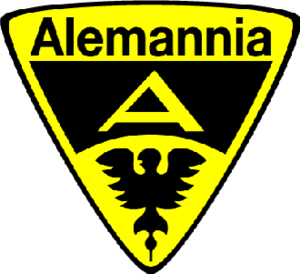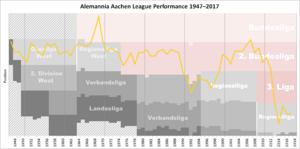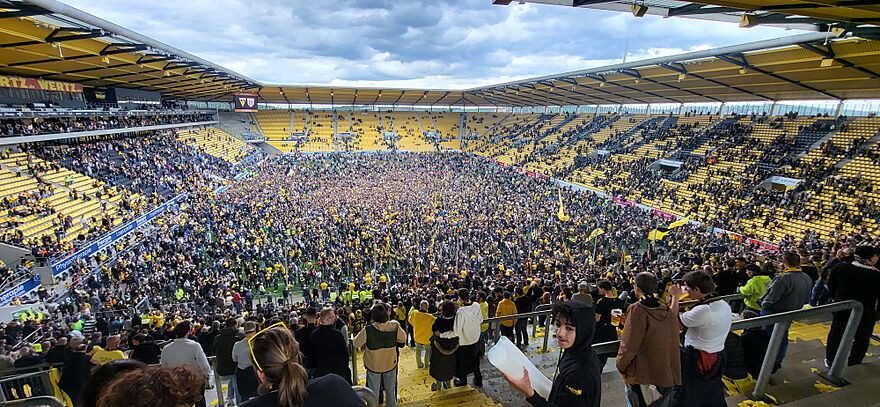Alemannia Aachen facts for kids
 |
|||
| Full name | Aachener Turn- und Sportverein Alemannia 1900 e. V. | ||
|---|---|---|---|
| Nickname(s) | Kartoffelkäfer (potato beetles) Die Alemannen (the Alemanni) |
||
| Founded | 16 December 1900 | ||
| Ground | Tivoli | ||
| Capacity | 32,960 | ||
| President | Björn Jansen | ||
| Manager | Benedetto Muzzicato | ||
|
|
|||
Alemannia Aachen is a German football club from the city of Aachen. This team is known for its yellow and black striped jerseys, which earned them the nickname "the potato beetles" (Kartoffelkäfer). Their home stadium is called the Tivoli.
Alemannia Aachen has played in Germany's top football league, the Bundesliga, several times. They were in the Bundesliga in the late 1960s and again for one season in 2006–07. After facing some tough times and even bankruptcy in 2012, the club worked hard to climb back up. In the 2023–24 season, they won their league, the Regionalliga West, and were promoted to the 3. Liga.
Contents
Alemannia Aachen's Story
How the Club Started
Alemannia Aachen was founded on December 16, 1900, by eighteen high school students. They chose the name "Alemannia" because it's a Latin word for Germany.
The First World War was very hard on the club. Many members were lost, and the club's size shrank a lot. After the war, in 1919, Alemannia joined with another local sports club, Aachener Turnverein 1847. However, this partnership didn't last long because the other club was more interested in gymnastics than football. They split up in 1924.
Aachen is close to the borders of Belgium and the Netherlands. Because of this, Alemannia often played against teams from these countries. They even have a friendly relationship with the Dutch club Roda JC Kerkrade, and both teams share the same club colors.
Early Success and Challenges
Alemannia won its first championship in 1907. As football became more popular, the club grew. They built their own stadium in 1928.
In the 1930s, German football was reorganized. Alemannia played in the top league, the Gauliga Mittelrhein, and even reached the national final rounds in 1938. The club was also one of the few sports teams at that time to stand up against the Nazi government by asking for a Jewish member to be released from jail.
After World War II
After World War II, Alemannia Aachen started playing football again in 1946. They returned to the top league the next year.
The club had some good moments in cup competitions. In 1953, they reached the final of the DFB-Pokal (German Cup) but lost. They made it to the DFB-Pokal final again in 1965, but lost to Borussia Dortmund.
Reaching the Bundesliga
In 1967, Alemannia Aachen won their division and were promoted to the Bundesliga, Germany's top professional league. The very next year, in 1968–69, they had their best season ever, finishing second in the league behind Bayern Munich. However, the following season was tough, and they were relegated back to the second division. By 1990, they had fallen to the third division.
The Road Back Up
In the late 1990s, the team started to improve. Their coach, Werner Fuchs, helped them play exciting football. In 1999, they were doing very well and were close to promotion when tragedy struck: Coach Fuchs passed away suddenly. The team pushed through, dedicating their promotion to him, and won the Regionalliga West/Südwest (third division).
The first few years back in the 2. Bundesliga were difficult, both on the field and financially. The club even faced bankruptcy. However, new leaders helped turn things around. They managed their money better and signed good players.
In the 2003–04 season, Alemannia Aachen became strong again. They reached the DFB-Pokal final for the third time, beating big teams like Bayern Munich. Even though they lost the final to Werder Bremen, Bremen had already qualified for the UEFA Champions League. This meant Alemannia Aachen got to play in the UEFA Cup (a European competition). They did well, reaching the Round of 32. Playing in these cups greatly improved the club's financial situation.
Return to the Top League and Recent Years
On April 16, 2006, Alemannia Aachen earned promotion back to the Bundesliga after 36 years! However, they only stayed for one season, getting relegated in 2007.
After that, the club faced a quick decline. They were relegated from the 2. Bundesliga in 2012 and from the 3. Liga in 2013. But Alemannia Aachen has been working hard to climb back. In the 2023–24 season, they finished first in the Regionalliga West and were promoted back to the 3. Liga. They are currently playing in the 3. Liga for the 2024-25 and 2025-26 seasons.
Alemannia Aachen's Seasons
This table shows how Alemannia Aachen has performed in different leagues and cups over the years:
| Year | Division | Position | Cup | Europe |
|---|---|---|---|---|
| 1967-68 | Bundesliga (I) | 11th | ? | ? |
| 1968-69 | Bundesliga (I) | 2nd | ? | ? |
| 1969-70 | Bundesliga (I) | 18th (relagated) | ? | ? |
| 1999–2000 | 2. Bundesliga (II) | 8th | First round | Not Qualified |
| 2000–2001 | 10th | Second round | ||
| 2001–2002 | 14th | Second round | ||
| 2002–2003 | 6th | First round | ||
| 2003–2004 | 6th | Final | ||
| 2004–2005 | 6th | Second round | UEFA Cup Round of 32 | |
| 2005–2006 | 2nd (promoted) | Second round | Not Qualified | |
| 2006–2007 | Bundesliga (I) | 17th (relegated) | Quarter-finals | |
| 2007–2008 | 2. Bundesliga (II) | 7th | Third round | |
| 2008–2009 | 4th | Second round | ||
| 2009–2010 | 13th | Second round | ||
| 2010–2011 | 10th | Quarter-finals | ||
| 2011–2012 | 17th (relegated) | First round |
3. Liga and Regionalliga West Seasons
| Year | Division | Position | Cup | FVM Cup |
|---|---|---|---|---|
| 2012–13 | 3. Liga (III) | 20th (relegated) | First round | Final |
| 2013–14 | Regionalliga West (IV) | 13th | Not Qualified | First round |
| 2014–15 | 2nd | Semi-final | ||
| 2015–16 | 7th | First round | ||
| 2016–17 | 7th | Second round | ||
| 2017–18 | 6th | Final | ||
| 2018–19 | 6th | Winner | ||
| 2019–20 | 6th | First round | Final | |
| 2020–21 | 14th | Not Qualified | Final | |
| 2021–22 | 12th | Semi-final | ||
| 2022–23 | 8th | Quarter-final | ||
| 2023–24 | 1st (promoted) | Winner | ||
| 2024–25 | 3. Liga (III) | 12th | First round | Final |
Team Players
Current Squad
Here are the players currently on the Alemannia Aachen team:
|
|
Club Achievements
Alemannia Aachen has won several titles and reached many finals:
- Bundesliga
- Runners-up (second place): 1968–69
- 2. Bundesliga
- Runners-up: 2005–06
- Regionalliga West (a lower division)
- Champions: 1964, 1966–67, 2023–24
- DFB-Pokal (German Cup)
- Runners-up: 1952–53, 1964–65, 2003–04
- Middle Rhine Cup
- Winners: 1992–93, 1993–94, 1996–97, 1998–99, 2002, 2006, 2019, 2024
- Western German Cup Winner:
- 1966–67
Famous Players
Many talented players have played for Alemannia Aachen. Some of them include:
- Roger Claessen (Belgium)
- Ivica Grlić (Bosnia and Herzegovina)
- Reinhold Münzenberg (Germany)
- Jupp Derwall (Germany)
- Lewis Holtby (Germany)
- Kai Havertz (Germany)
- Torsten Frings (Germany)
- David Odonkor (Germany)
- Jan Schlaudraff (Germany)
- Angelo Nijskens (Netherlands)
Home Stadium: The Tivoli
Alemannia Aachen used to play at the Old Tivoli stadium. It was built in 1928 and could hold over 21,000 fans. For some big European matches, like the UEFA Cup games in 2004, the club had to play in Cologne's RheinEnergieStadion because the Old Tivoli wasn't big enough.
In August 2009, Alemannia Aachen opened a brand new stadium, also called the New Tivoli. This modern stadium can hold 32,960 spectators, including many standing areas for fans.
Basketball Team
Did you know Alemannia Aachen also had a very successful basketball team? They reached the German Championship final twice, in 1959 and 1962. Then, they won the championship two years in a row, in 1963 and 1964!
Basketball Achievements
- Basketball Bundesliga:
- Champions: 1963, 1964
- Runners-up: 1959, 1962
See also
 In Spanish: Alemannia Aachen para niños
In Spanish: Alemannia Aachen para niños




